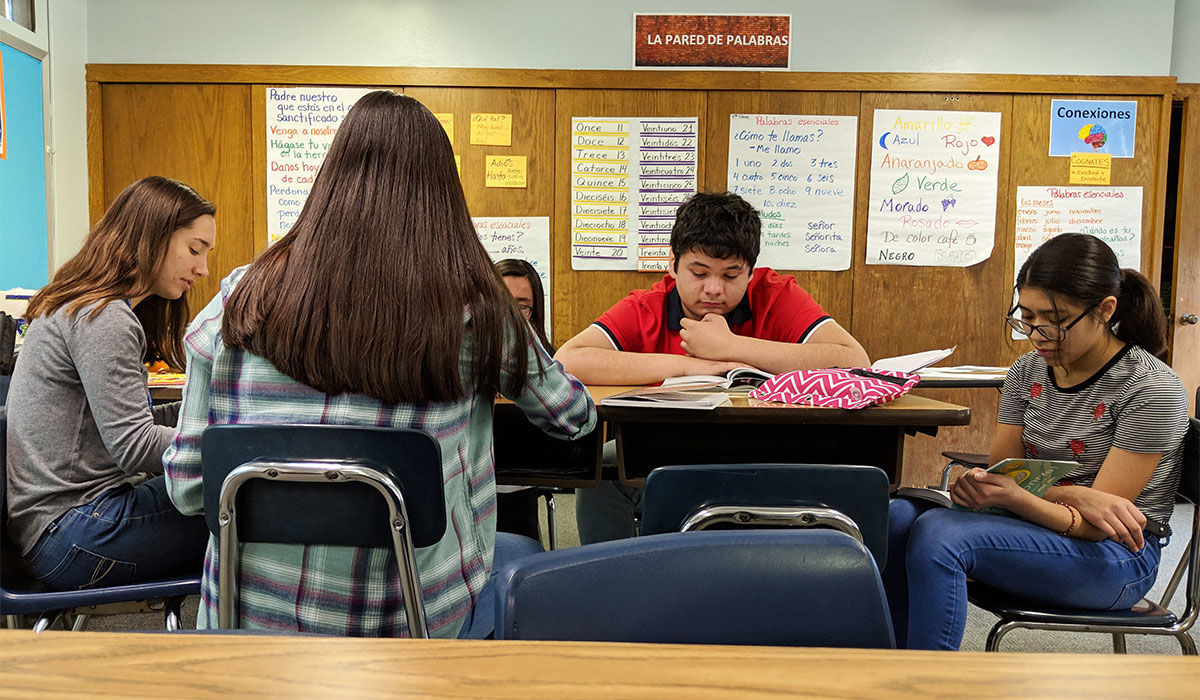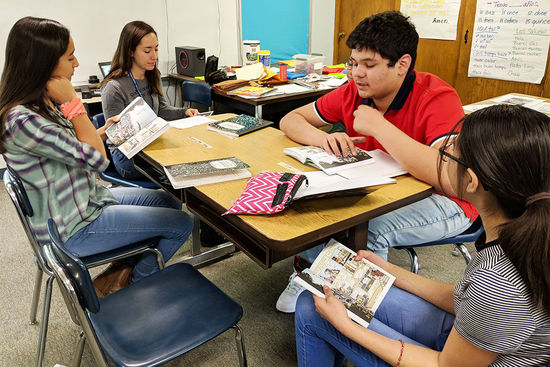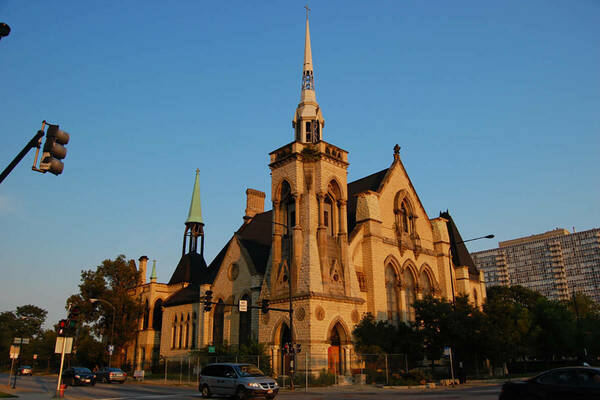 Sociology major Julia Cogan (left) leads a heritage book club for middle-school students at South Bend's Holy Cross School.
Sociology major Julia Cogan (left) leads a heritage book club for middle-school students at South Bend's Holy Cross School.
Every Thursday, Notre Dame junior Julia Cogan drives the six minutes from campus to Holy Cross School, a Catholic school on South Bend’s near northwest side — a socially and economically diverse area of the city where an increasing number of young people speak one language at home and another at school, straddling a wide and often disorienting lingual and cultural divide.
There, Cogan, a sociology major with a minor in teaching English to speakers of other languages, leads a heritage book club for middle-school students in Clare Roach’s introductory Spanish class. The students speak Spanish at home — easily conversing with Spanish-speaking padres (mothers and fathers), tios (aunts and uncles) and abuelos (grandmas and grandpas) — but struggle to read and write in Spanish because it is not the traditional language of education in South Bend.
Roach, coordinator of the two-way immersion program at Holy Cross as well as the English as a New Language Program at the Alliance for Catholic Education (ACE) at Notre Dame, calls these sixth-, seventh- and eighth-grade students her “too-smart people.”
“These kids speak Spanish better than I do; they don’t need to be in an introductory Spanish class where they’re learning colors and numbers and basic greetings,” Roach said. “They’re too linguistically skilled for that.”
“Everything about this, the word I would use is dignifying. It dignifies the skill set of the children, it dignifies their reality; it dignifies the talents of our Notre Dame undergrads and their capacity to make a difference in the lives of children locally; it dignifies what we’re trying to do at Holy Cross, which is to increase people’s understanding and appreciation of bilingualism.”
— Clare Roach, Notre Dame Alliance for Catholic Education
The latest in a long line of Notre Dame-backed programs and initiatives aimed at improving educational outcomes for primary and secondary students in the South Bend-Elkhart region, the book club, now in its second year, provides Holy Cross students of Hispanic heritage an opportunity to become scholars in their native language within a collaborative learning environment that promotes discussion and problem solving.
“This just sends a wonderful message” about the value of Spanish language and culture in both the church and the classroom, said Angela Budzinski, Holy Cross principal.
About Notre Dame’s involvement in the club, Budzinski said, “I think it would have been extremely difficult to do without Notre Dame; they’ve been a true partner in this process.”
On a recent Thursday, four students from Roach’s eighth-grade Spanish class — three girls and one boy — sat around a small, rectangular table talking about Sonrie! an award-winning graphic memoir by Raina Telgemeier about a girl who endures a series of dental operations and appliances after a fall, in addition to an earthquake, boy trouble and unreliable friends in her hometown of San Francisco.
Taking turns reading aloud, the students soon reached the point in the book about the “terremoto,” or earthquake, prompting a discussion of other Spanish-language words for natural disasters, including “inundacion.”
“Is that a flood?” one of the students whispered in English.
“Yes,” his classmates giggled.
“En español,” said Cogan, who in addition to leading the book club also teaches English to Spanish-speaking adults at La Casa de Amistad, a Hispanic community center in South Bend.
Elevating the language
Newcomers to South Bend have settled on the west side for generations, making it one of the most diverse areas of the city. Polish immigrants led the way, followed by blacks fleeing the south for more freedom and better opportunities in the north and, more recently, Spanish-speaking immigrants from Mexico and other Latin-American countries.
Today, parts of the west side are more than 60 percent Hispanic, according to census data, with many families speaking primarily Spanish at home. Holy Cross is divided almost evenly between white, black, and Hispanic students.
Similar demographic shifts have reshaped the Catholic Church. Since 1991, the percentage of self-identifying Catholics in the U.S. who identify as Hispanic has grown from less than 10 percent to about 40 percent, according to the U.S. Conference of Catholic Bishops. More than half of Catholics in the U.S. under the age of 30 identify as Hispanic.
That’s true on the west side, where Catholic parishes founded by European immigrants around the turn of the last century now offer services in both English and Spanish. St. Adalbert Catholic Parish, founded by Polish-Americans in the early 1900s and now located in the heart of the Hispanic community in South Bend, is more than 50 percent Hispanic.
 The book club developed as a way to promote bi-literacy — the ability to read and write in two languages — among older Spanish-speaking students who grew up learning to read and write in just one language: English.
The book club developed as a way to promote bi-literacy — the ability to read and write in two languages — among older Spanish-speaking students who grew up learning to read and write in just one language: English.
Embracing that reality, Holy Cross, in collaboration with ACE and the Institute for Latino Studies at Notre Dame, launched a two-way immersion program for pre-K students during the 2017-18 school year.
The program, which prioritizes Spanish in the early grades, expanded to kindergarten this year. It will continue to advance one grade level each year, incorporating more English into the curriculum each grade until instruction is evenly split between Spanish and English.
In addition to promoting mastery of Spanish and English and positive cross-culture attitudes and behaviors among students of different backgrounds, the program aims to “elevate the status of Spanish” as a scholarly language, Roach said, so that it is seen as equal to, rather than secondary to, English.
“The fact that (heritage Spanish speakers) speak a language other than English at their kitchen table is not always something that they want to highlight because it spotlights them as different,” Roach explained. “They don’t recognize that their Spanish language is an asset. It’s something that they want to hide.”
But it is an asset, Roach said.
According to the U.S. Department of Education, compared with their non-bilingual peers, bilingual children have an easier time understanding math concepts and solving word problems, developing strong thinking skills, using logic, focusing, remembering and making decisions, thinking about language, and learning about other languages.
They also maintain stronger ties with their family, culture and community, Roach said, face better job prospects as adults and benefit from the opportunity to more fully participate in the global community.
‘Fun’ but ‘challenging’
The book club evolved in parallel with the immersion program, Roach said, as a way to promote bi-literacy — the ability to read and write in two languages — among older Spanish-speaking students who grew up learning to read and write in just one language: English.
“I recognized that these kids had a linguistic skill set that would not be met in a traditional introductory Spanish class, so I quickly scrambled to find some resources within the community to meet their unique educational needs and to leverage this blessing that they have, this educational gold that they have, which is that they have a language base in Spanish and in English,” Roach said.
That search led to Tim Jacklich, a political science and Spanish major from Glen Ellyn, Illinois. A sophomore at the time, Jacklich was looking to plug a hole in his fall schedule when he stumbled upon an opening for a Spanish-language teacher at Holy Cross — part of the school’s effort to staff up for the new immersion program.
Jacklich inquired about the opening, which led to a conversation about the book club.
“I put out a couple of emails to professors I knew at Notre Dame and they cast the net,” Roach said. “And Tim reaches out to me and says, ‘I’m free on Thursday mornings. I’m a Spanish major. Maybe I can help.”
Problem solved.
Two weeks later, Jacklich led his first group of Spanish-speaking Holy Cross students in a discussion of Fantasmas, or Ghosts, a graphic novel — also by Telgemeier — about Catrina, a young girl from a multicultural family who must adjust to a sudden move and learn to accept her sister’s fate as someone with cystic fibrosis.
“I loved the kids. They were just so bright and certainly very welcoming to me and very forgiving when I would make mistakes in Spanish.”
— Tim Jacklich, political science and Spanish major and former book club leader
Jacklich, who had little teaching experience at the time, worked with Roach and Elena Mangione-Lora, associate teaching professor of Spanish in the Department of Romance Languages and Literatures at Notre Dame, to develop the curriculum and plan lessons for the club.
“As I got better, I started to plan mini-grammar lessons around the text,” Jacklich said. “So if I noticed a certain verb form or sentence structure I would make note of it and talk to the students about it.”
“It was fun,” he said, “but it was challenging. We were sort of figuring it out as we went.”
About the students, Jacklich said, “I loved the kids. They were just so bright and certainly very welcoming to me and very forgiving when I would make mistakes in Spanish.”
Occasionally, he said, the students would correct his Spanish.
“And how amazing is that?” Roach said. “Because every time that happens, you’re saying to a child, ‘You know, I’m learning too.’”
Jacklich described his fluency in Spanish as intermediate. He spent the summer after his sophomore year teaching at a largely Spanish-speaking school in Tucson through ACE, and he plans to study in Mexico next semester through Notre Dame International. But the book club remains his most immersive experience with Spanish outside of the classroom.
“A unique aspect of it was how much we learned from each other,” Jacklich said of the club.
For example, he said, it was a student who pointed out that Catrina, the protagonist in Fantasmas, shared a name with La Calavera Catrina, the referential image of Death in Mexico and an icon of Day of the Dead, a Mexican holiday that is central to the plot of the book.
Introduced by Mexican printmaker and illustrator Jose Guadalupe Posada in the early 1900s, La Calavera Catrina is a satirical portrait of those Mexican natives who aspired to adopt European aristocratic traditions in the pre-revolution era. In other words, like the students, she inhabits two worlds simultaneously.
“I would never have picked up on that detail,” Jacklich said.
Why a book club?
According to Roach, “There’s not a lot of stress associated with a book club.” It encourages debate and discussion, Roach said, and “it’s fun.” Especially when the person leading the club is a student as well, and not just a teacher.
 Centering a book discussion around a graphic novel allows the students to engage in a sophisticated discussion while still interacting with a text that offers visual clues and other support for developing literacy skills.
Centering a book discussion around a graphic novel allows the students to engage in a sophisticated discussion while still interacting with a text that offers visual clues and other support for developing literacy skills.
Budzinski, the principal, said, “We wanted to take these kids and show them that there is something in the Spanish program in sixth, seventh and eighth grades that’s good for them too.”
As for the decision to build the club around a graphic novel, Roach said, “These students should be starting with early readers in Spanish. But you don’t want to go to a seventh-grader with baby books; that’s the quickest way to shut that seventh-grader down. So the beauty of the graphic novel is it doesn’t feel baby-ish, and yet there is all this support” — visual clues, especially — “for developing literacy skills.”
Along with Jacklich, Roach detailed these and other insights about the book club in a widely shared piece for Edutopia, an educational website of the George Lucas Educational Foundation, a nonprofit that celebrates and encourages innovation in K-12 education.
The biggest takeaway?
“You don’t have to hire a whole new teacher to engage non-English speakers and promote bilingualism in the classroom; you just have to reach out to your community and see what assets are available,” Roach said. “And we’re lucky enough to have a world-class university in our backyard.”
And students such as Cogan and Jacklich willing to lend a hand.
A ‘dignifying’ experience
Back in the classroom, Cogan wrote on the white board, “¿Has encontrado un desastre natural (have you ever experienced a natural disaster)?” and drew a pair of lines to the words “Si (yes)” and “No (no).”
One of the students spoke about recent flooding in South Bend. The city experienced heavy snow and rain in February, sending the St. Joseph River spilling over its banks and into homes and businesses. Swamped wastewater sewers also contributed to basement flooding throughout the city.
Cogan, in turn, shared her own experience with natural disasters as a native of Missouri, part of the area across the central U.S. known as Tornado Alley, describing the look of the sky — “like a gray/green color” — before a coming twister.
Cogan started leading the book club this fall, the result of a fortuitous conversation with Michael Comuniello, associate director for recruiting with ACE.
 Cogan (second from left) heads to Holy Cross once a week to lead book club discussions.
Cogan (second from left) heads to Holy Cross once a week to lead book club discussions.
Jacklich, who is on track to graduate early next fall, had recently stepped away from the club because of a conflict with school, and Cogan was talking to Comuniello about her work with Spanish-speaking adults in South Bend when he mentioned the opening.
Cogan was intrigued.
“I love working with adults, but I really love working with children too, so I was looking for an opportunity to do that as well,” Cogan said.
Like Jacklich, Cogan described the experience as “rewarding (but) challenging,” especially “talking about linguistic stuff” in Spanish or “making sure I’m using words correctly when I’m with the kids.”
A native of St. Louis, Cogan became interested in Spanish, and language in general, in high school. She took Spanish classes, and she was active in her school’s Spanish Club. She also worked as a teaching assistant at a Catholic school with a large number of Hispanic students. And she spent multiple summers in Nicaragua, where the official language is Spanish.
More recently, as a Notre Dame student, Cogan spent the summer after her freshman year running an English-language program in Peru with support from First Year of Studies. She spent the following summer in Brazil after learning Portuguese. And she’ll study in Toledo, Spain, next semester through Notre Dame International.
Ever humble, she described her proficiency in Spanish as “fluent, probably,” noting she occasionally relies on English while leading the book club.
Budzinski, for her part, praised Notre Dame generally — and Cogan, Jacklich and Roach specifically — for their contributions to the book club as well as the immersion program more widely, saying, “The success of the program truly is because we have this partnership with Notre Dame.”
Said Roach, “Everything about this, the word I would use is dignifying. It dignifies the skill set of the children, it dignifies their reality; it dignifies the talents of our Notre Dame undergrads and their capacity to make a difference in the lives of children locally; it dignifies what we’re trying to do at Holy Cross, which is to increase people’s understanding and appreciation of bilingualism.”
Originally published at news.nd.edu.


